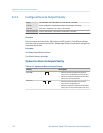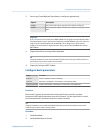
6.6 Configure digital communications
The digital communications parameters control how the transmitter will communicate
using digital communications.
Your transmitter supports the following types of digital communications:
• HART/Bell 202 over the primary mA terminals
• HART/RS-485 over the RS-485 terminals
• Modbus/RS-485 over the RS-485 terminals
• Modbus RTU via the service port
Note
The service port responds automatically to a wide range of connection requests. It is not
configurable.
6.6.1 Configure HART/Bell 202 communications
Display OFF-LINE MAINT > OFF-LINE CONFG > COMM
ProLink II ProLink > Configuration > Device > Digital Comm Settings
ProLink III Device Tools > Configuration > Communications > Communications (HART)
Field Communicator Configure > Manual Setup > Inputs/Outputs > Communications > HART Communications
Overview
HART/Bell 202 communications parameters support HART communication with the
transmitter's primary mA terminals over a HART/Bell 202 network.
The HART/Bell 202 communications parameters include:
• HART Address (Polling Address)
• Loop Current Mode (ProLink II) or mA Output Action (ProLink III)
• Burst Parameters (optional)
• HART Variables (optional)
Procedure
1.
Set HART Address to a unique value on your network.
Valid address values are between 0 and 15. The default address (0) is typically used
unless you are in a multidrop environment.
Tip
Devices using HART protocol to communicate with the transmitter may use either HART
Address or HART Tag (Software Tag) to identify the transmitter. Configure either or both, as
required by your other HART devices.
Integrate the meter with the control system
124 Micro Motion
®
Model 2700 Transmitters with Analog Outputs


















